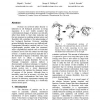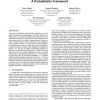RECOMB
2001
Springer
14 years 12 months ago
2001
Springer
The Smith-Waterman algorithm for local sequence alignment is one of the most important techniques in computational molecular biology. This ingenious dynamic programming approach w...
RECOMB
2001
Springer
14 years 12 months ago
2001
Springer
motif discovery problem abstracts the task of discovering short, conserved sites in genomic DNA. Pevzner and Sze recently described a precise combinatorial formulation of motif di...
RECOMB
2001
Springer
14 years 12 months ago
2001
Springer
A method is presented that uses b-strand interactions to predict the parallel right-handed b-helix super-secondary structural motif in protein sequences. A program called BetaWrap...
RECOMB
2001
Springer
14 years 12 months ago
2001
Springer
Phylogenetic footprinting is a comparative genomics approach for predicting transcription factor binding sites, where a set of orthologous regulatory regions are compared and short...
RECOMB
2002
Springer
14 years 12 months ago
2002
Springer
We present an original approach to identifying sequence variants in a mixed DNA population from sequence trace data. The heart of the method is based on parsimony: given a wildtyp...
RECOMB
2002
Springer
14 years 12 months ago
2002
Springer
Proteins are involved either directly or indirectly in all biological processes in living organisms. It is now widely accepted that conformational changes of proteins can critical...
RECOMB
2002
Springer
14 years 12 months ago
2002
Springer
Biological data, such as gene expression profiles or protein sequences, is often organized in a hierarchy of classes, where the instances assigned to "nearby" classes in...
RECOMB
2002
Springer
14 years 12 months ago
2002
Springer
We present a probabilistic framework that models the process by which transcriptional binding explains the mRNA expression of different genes. Our joint probabilistic model unifie...
RECOMB
2002
Springer
14 years 12 months ago
2002
Springer
There are many critical situations when one needs to rapidly identify an unidentified pathogen from among a given set of previously sequenced pathogens. DNA or RNA hybridization c...
RECOMB
2002
Springer
14 years 12 months ago
2002
Springer
A recent idea for determining the three-dimensional structure of a protein uses antibody recognition of surface structure and random peptide libraries to map antibody epitope comb...



